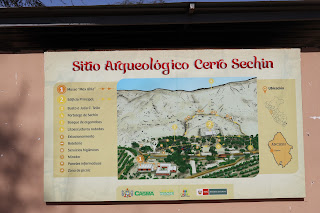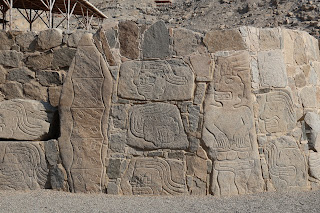Cerro Sechín (also Sechín de las Estelas) is an archaeological site in
Casma Province of Ancash Region in northern Peru.
Dating to 1600 BCE, the site was the capital of an entire culture, now known
as the Casma/Sechin culture or Sechin complex.
Notable features include megalithic architecture with carved figures in
bas-relief, which graphically dramatize human sacrifices. The slabs at Cerro
Sechin may represent the central Andes' oldest known monumental sculpture.
There is a small on-site museum.
|
Information poster of the Sechin archaeological complex
Cerro Sechín sits on a granitic hill, in the Casma Valley.
-
It is located 1 kilometre (0.62 mi) east of the Pan-American Highway,
5 kilometres (3.1 mi) from the provincial capital of Casma and 168
miles (270 km) north of Lima. It is situated 13 kilometres (8.1 mi)
from the Pacific Ocean, near the confluence of the Sechin and Moxeke
Rivers at an altitude of 90 metres (300 ft) above sea level.
|
Main building
|
Panorama of the main building
The main building is 51 square metres (550 sq ft) and 4 metres (13 ft)
in height.
-
Though roofs no longer survive, their design is evidenced on pottery
vessels.
-
The temple, rectangular in design with rounded corner, was constructed
of conical adobes; its entrance is on the north side.
-
Its perimeter wall of monoliths or stelae is of earlier construction.
- A double staircase, about 1.2 m (4 ft) high, leads to the top.
|
|
Engravings of the northeast corner of the main building
The most striking feature of the stone building is its lithic block
facade decorated with reliefs representing "warrior-priests" and
mutilated bodies.
-
The etched bas-reliefs number approximately 300, from axe-wielding
warriors, to body parts, and victims, who are decapitated and
mutilated.
-
The characters are of two types: the warrior-priests (wearing a weapon
or scepter) and dismembered victims or their offal (mainly heads,
limbs, eyes skewered, intestines, vertebrae and viscera).
-
These figures represent humans and demigods, without the presence of
animals.
|
|
Left side of the north facade of the main building
|
|
Engravings on the left side of the north facade of the main
building
|
|
Entrance to the main building
|
|
Engravings on the right side of the north facade of the main
building
|
|
Lithosculptures of the main building of Cerro Sechin
The scenes depicted on the front are quite symmetrical, repeating
themselves on both sides of the door.
|
|
Distribution of engravings around the main building
The designs of the lithosculptures have allowed researchers to generate
hypotheses about the advanced knowledge of human anatomy through
vivisection, the knowledge of organic systems such as the digestive
system, blood circulation and even certain pathologies that show their
concern for the study of man and with it the bases of human medicine
3,800 years ago.
|
|
Interpretation of the engravings
-
Left engraving - Main character, he carries a club and from his
more elaborate outfit hangs four trophy heads and his plume or cap has
a sea wave and three bands of hair in the shape of waves. He is
located next to the north portal.
-
Center left engraving - Left: DIGESTIVE SYSTEM, right:
SECTIONED LIMBS. Representation of limbs with blood spurting out and
organs separately or together, like the lithosculpture of the
digestive system.
-
Center right engraving - MUTILATED PRISONERS. Character
portrayed with dilated pupils and expression of pain and terror that
would indicate the practice of "vivisection" (an anatomical
exploratory procedure on living beings).
-
Right engraving - Left: SECTIONED HEADS, right: STACKED HEADS.
Heads have a symbolic meaning, they are the most represented graphics
in Sechín. Most of them are “enucleated”, that is, the eyeball has
been removed.
|
|
West wall of the main building
|
Casma Regional Museum "Max Uhle"
|
Museum building
The Casma Regional Museum "Max Uhle" is a Peruvian museum, which is
located in the Casma district of the homonymous province in the
department of Ancash. It was opened on August 25, 1984. It is located in
the Sechín archaeological complex.
-
The museum houses ceramics from the Chavín, Wari, Chimú cultures.
|
|
IV Idol of the platform of the Mojeque temple
This character was located in one of the niches of the Mojeque temple as
part of the architectural decoration carried out in high relief. It
possibly represents a deity. Dressed in a cloak. Only the central part
and part of the body decorated with polychrome paint have been
preserved.
- Dimensions: 3.85 m (13 ft) large and 1.97 m (6 ft) high.
|
|
General view of the interior of the museum
|
|
Display with ceramic pieces
|
|
Personage at home
Virú sculptural two-body bottle. Sechín. 100 BCE - 400 CE.
|
|
Virú decorated bottle
Sechín. 100 BCE - 400 CE.
|
|
Virú ceremonial pot with face
Sechín. 100 BCE - 400 CE.
|
|
Chimú tripod vessel with decoration
Casma. 1350 - 1500 CE.
|
|
Chimú decorated bottle with two handles at mid-body
Sechín. 100 BCE - 400 CE.
|
|
Stone mortar with engraved Sechín head
Sechín valley. 1650 BCE.
|
|
Stone mortar with formative design
San Juanito - Valle del Santa. 1800 BCE.
|
|
Construction phases of the main building
-
Top - FIRST ADOBE TEMPLE: Built with conical adobe walls and
mud mortar from 2500 BCE, it consists of a central chamber with
rounded corners and painted dark blue on the inside. It also has an
atrium, chambers and an upper terrace. On the façade of the central
chamber, felines are painted on each side, in black, white and red on
a pink background.
-
Middle - SECOND TEMPLE: Built with conical adobe bricks joined
with mud mortar on the First Temple and most of the old buildings. It
has a façade with fish designs and has a front staircase leading to a
very destroyed platform.
-
Bottom - THIRD TEMPLE: Built with stone walls on the previous
temples, its façade depicted the scene Procession of the Warriors. It
was remodeled and later partially covered by a landslide around the
year 1650 BCE.
|
Scale model of the main building
|
Interior view
In the interior of the adobe building, the main decoration is the best
preserved. It depicts two mythological fish. Another figure depicts a
man bleeding.
-
These depictions closely relate to the sea, rain and human sacrifices.
|
|
View of the atrium and the sacred chamber
|
See also
Source
Location




















































